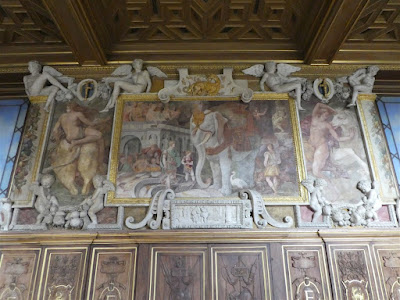While Vicki rested that evening, I walked over to the Musee des Arts et Metiers for its free Friday evening hours. This is a museum of the history of science and technology, housed in a huge former abbey (became available after 1789) that is just a block away. It brings you up to date science-wise, sort of, although I suspect the most recent stuff is up in the Parc Villette. Anyhow, I'd been wanting to see the nearby Musee for some time, mostly out of appreciation for France's role in the Enlightenment and in the growth of science and technology. Also because I read Umberto Eco's creepy Foucault's Pendulum some years ago, and the Musee des Arts et Metiers is where the pendulum was, and is. The displays are mostly old-fashioned, as one would expect in a building complex that is centuries old (so is the Musee itself), and my visit was hampered by the fact I don't know much science and technology*, and that the Musee's descriptions and explanations are mostly in French. I have brutally reduced the number of pix to fit into one long post. The items rejected are nearly as important or interesting, historically, as those retained.
 |
Just a couple of the principal buildings; someone else's photo:
it was a dark and stormy night when I was there |
 |
| Big abbey, now big museum |
 |
Can't do much science or technology without measuring or
counting things; the first big hall in the museum is about developing
the instruments for this and the standardization necessary; here,
astrolabes |
 |
| Weights |
 |
| Volumes |
 |
| Temperature |
 |
| Time |
 |
| A whole huge hall of these and other measuring-type things... |
 |
| Pascal's computing machines |
 |
| Lavoisier's laboratory...father of chemistry |
 |
| Device for determining and measuring the outputs of combustion |
 |
| Moving right along...a 1937 cyclotron |
 |
| Cray computer (remember them?) |
 |
| Electron microscope |
 |
From about this point the museum is organized into various topics... machines, manufacturing, communication, energy, transportation...here an early loom among the machines |
 |
A large display on the history, development, and manufacturing
of cardboard boxes |
 |
| Construction models aplenty, showing design and technique |
 |
| The earliest magic lanterns |
 |
| Stereo! |
 |
The Marly machine, 1684, which lifted water from the Seine and
sent it on its way to the lakes, ponds, and fountains of Versailles |
 |
| Halls and halls of these things |
 |
In a theatre of automata...among others, Marie Antoinette's 1784
dulcimer-playing puppet |
 |
Clement Ader's Avion III, a canvas, twin (steam) engined, bat-
shaped heavier-than-air craft, later 1890s; crashed, taxiing;
if nothing else, established the word avion as the French term
for airplane |
 |
| Model of an early Stephenson locomotive |
 |
Velocipides...developed not much earlier than cars and planes; but not trains |
 |
Peugeot Quadricycle; gasoline engine powered; 1893; gee, why didn't
the term "quadricycle" stick? |
 |
Wind-tunnel version and model of the TGV ("train of great
velocity") |
 |
Now into the final big hall, that is, the former church of the former
abbey...with planes, cars, statues, and a pendulum |
 |
| Model for the Statue of Liberty |
 |
| Renault Formula I of note |
 |
| Bleriot and other early aircraft |
 |
| And Foucault's Pendulum |
 |
It was after regular hours when I finished up, and the gift shop
was already closed; but I exited anyway
|
*My last (and first) scientific endeavor was in 1963 or so, after 10th grade, when I held a Heart Association summer fellowship at the Howard Hughes Medical Institute in Miami, under Dr. Nancy Noble, who also taught at the U of M. For the better part of the summer, I subjected radiated chicken embryo bits to the centrifuge and then analyzed whatever came out...resulting in a paper entitled "Mucopolysaccharide Synthesis at the Cell Particle Level," which she mostly wrote but put my name on. I also learned the meaning of the term "stipend" and got $300 for my efforts, which was a lot of money for a kid in those days. Nonetheless, from this experience, I think I began to see I was not cut out for the tedium and teamwork of science. Reading history, literature, philosophy, and religion seemed a lot more fun, plus you didn't have to get your hands dirty. Or have your results replicated.









































































